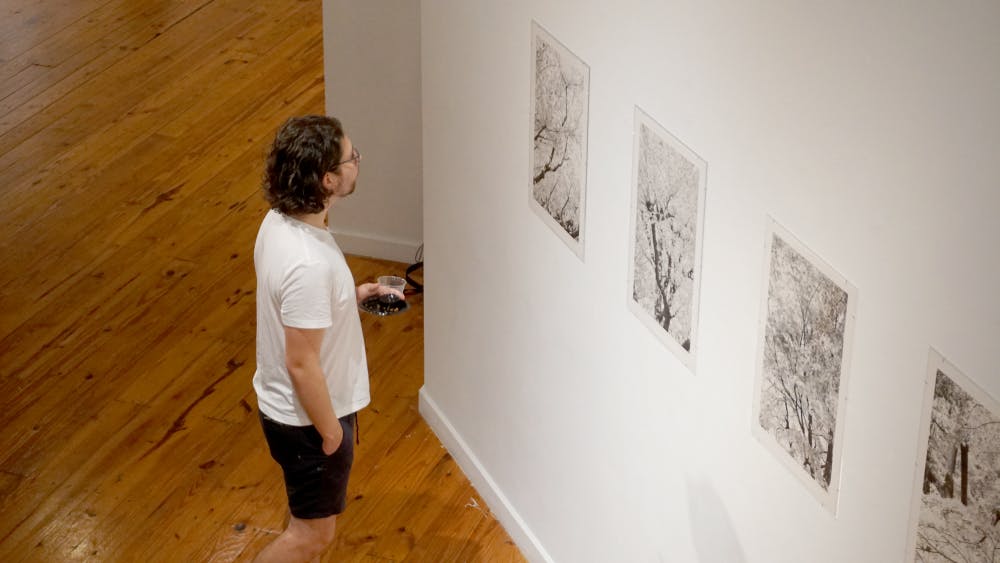Rice Media Center hosts Agustin Estrada’s ‘Shizen: On the Art of Looking at Nature’

Agustín Estrada’s photography exhibit “Shizen: On the Art of Looking at Nature,” which showcases intricate perspectives of nature in the context of Japanese culture, opened at the Rice Media Center Main Gallery Tuesday, Sept. 18. While “Shizen” translates directly to “nature,” this broad term is categorized into three distinct aspects that are individually explored and developed by Estrada. The first is “Niwa,” Japanese ponds and gardens that serve as “pure places” to interact with nature. The second is “Hanami,” the blooming of flowers in early spring, and the third is “Momiji,” the falling and changing colors of leaves in autumn.
Estrada is a professional photographer, digital consultant and book producer based in Mexico City who demonstrates a distinct style of intimate close-ups, shadows and use of monochrome. After 30 years working in publishing, production and freelance photography in Mexico City, Estrada took an acute interest in Japanese culture and has dedicated the past 10 years to capturing it. The blending of Estrada’s Mexican cultural background and in-depth exploration of Japanese culture drives his unique approach to photography. During the opening reception, I heard a Spanish conversation to my right and a Japanese one to my left, which I felt truly spoke to Estrada’s adept ability to traverse and unite cultures through art.
According to an informational placard for “Niwa,” Estrada believes that “reverence for the observation of nature is a common attitude among the Japanese.” He said these sacred gardens were created to provide “a physical and visual transition” to a state of inner peace and personal contemplation within nature. Estrada succeeds in visually capturing the essence of serenity and silence with black-and-white stills of gardens thriving with flora and fauna. In a world that places so much value on perpetual motion, it was comforting to remember nature’s enduring tranquility.
The photographs representing “Hanami” spotlight the blossoming of Japanese cherry blossoms, or “sakura.” Estrada takes advantage of the blossoms’ natural orientation over bodies of water by capturing their structural reflections. This technique provides an opportunity to admire the blossoms in more dimension than they are traditionally observed.
Many of the photographs depicting “Momiji” capture aspects of nature that are normally dismissed or taken for granted, such as barren branches and fallen leaves. Although images of autumn are ones familiar to us, the opportunity to examine them closely initiates a sense of appreciation. Estrada uses these photographs to emphasize the beauty of decay and necessity of death in nature.
My favorite photograph is of a solitary koi fish with a shadow falling right in the middle of its body. The contrast of light and darkness on the fish is reminiscent of a yin yang, and therefore speaks to the duality of nature. I felt that this picture captured the volatility of not only nature, but each individual creature that exists in an eternal cycle of life and death.
With this exhibit, Estrada promotes the sanctity of nature that is often dismissed by hyper-urbanized societies. “Shizen: On the Art of Looking at Nature” will be on display for free at the Rice Media Center Main Gallery through Oct. 25 between 10 a.m. and 5 p.m.
More from The Rice Thresher

ktru’s annual Outdoor Show moves indoors, still thrills
ktru’s 33rd annual “Outdoor Show” music festival shifted indoors March 29 due to concerns about inclement weather. Despite the last-minute location change, attendees, performers and organizers said the event retained its lively atmosphere and community spirit.

Rice’s newest sculpture encourages unconventional ‘repair’
A white-tiled geometric sculpture sits on the outer corner of the academic quad, between Lovett and Herzstein Halls. A variety of materials – string, pins, ribbon – are housed on the structure in plastic containers.

Review: ‘Invincible’ Season 3 contemplates the weight of heroism
When I think of "Invincible," I immediately picture Mark Grayson at the emotional center of his universe, much like Spider-Man anchors the Marvel world. Mark is a hero deeply shaped by tragedy, yet driven by a seemingly impossible desire to remain good. Despite pure intentions, his efforts often backfire spectacularly. And ultimately, despite his reluctance, he faces uncomfortable truths about what it genuinely means to be heroic.

Please note All comments are eligible for publication by The Rice Thresher.